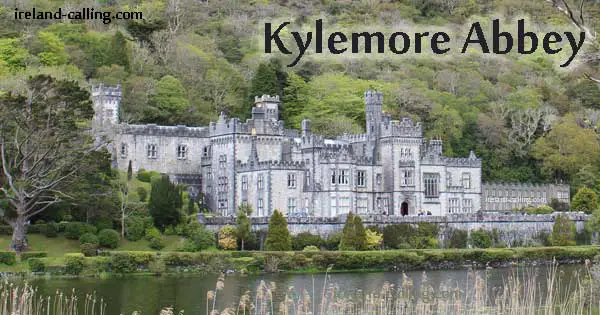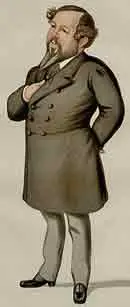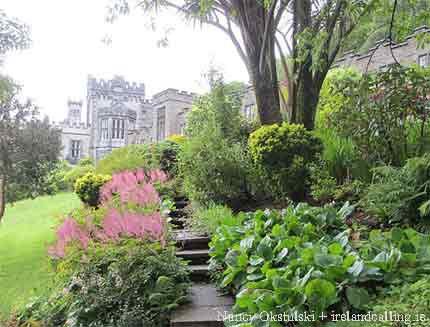A grand romantic gesture can be a great way for a husband to show his wife just how much she still means to him.
An unexpected bunch of flowers, a surprise weekend away, or home cooked meal are just some great ways to keep the spark in a marriage and remind each other how happy you are together.
Or how about the husband building a fairytale castle as a romantic gift for his wife? That guy you would have to say, had some ‘game’.
That was exactly what English doctor Mitchell Henry did as a gift for his beloved wife Margaret, when he ordered the building of Kylemore Abbey in County Galway, Ireland.

Love of Connemara
Mitchell and Margaret Henry began building Kylemore Castle as a private home in 1867 – it took 14 years to complete. The couple first visited Connemara on their honeymoon and loved the beauty of the area.
The Henrys often visited Connemara during the fishing season and rented Kylemore Lodge – and this is the site where they later built Kylemore Castle.

When his father (a Manchester cotton merchant) died, Henry’s inheritance enabled him to buy Kylemore Lodge with 13,000 acres of land. When he moved over to Ireland, he gave up his medical career and went into politics.
He became the Galway Member of Parliament in the House of Commons for 14 years, from 1871 to 1885.
Castle and gardens for £18,000
Mitchell built the grand fairy-tale castle as a romantic gift for his wife Margaret. He established structured gardens, walks and woodlands which covered 13,000 acres. The main castle walls are up to three feet thick. The castle has over 70 rooms, including 33 bedrooms, plus rooms for offices and bedrooms for in-house staff – butler, cook, housekeeper and other servants.
It took one hundred men to complete the building. The total cost was just over £18,000.
Henry had his tenants reclaim the wasteland bogland of Connemara, and in forty years, had turned the unproductive bog into the profitable Kylemore Estate resulting in more prosperity for the local people bringing many social benefits to the whole region after the devastation of the Great Irish Famine. Henry provided work and houses for his tenants. He later built a school for his workers’ children. He was one of the fairest landlords in Ireland at the time.
In 1903, Duke and Duchess of Manchester bought the castle, funded by the Duchess’ father, Eugene Zimmerman, the American businessman. However, they had to sell it in 1914 when Eugene Zimmerman died, as they couldn’t afford the mortgage.
Irish Benedictine Nuns buy Kylemore for £45,000
The Benedictine Nuns bought Kylemore Castle and 10,000 acres of land, in 1920, for £45,000. They came to Kylemore in 1920 after their abbey in Ypres, Belgium was destroyed in World War I. The Castle was converted into an Abbey.
They later sold some the land to the Land Commission who divided it between the tenants.
International Boarding School
Irish nobility sent their daughters to be educated by the Benedictine nuns when they were based in an abbey in Ypres. They were known as the ‘Irish Dames of Ypres’.
Oscar Wilde described the Connemara region as having “a savage beauty” with its unspoilt and natural landscape.
They established a boarding school for girls in Kylemore – renowned around the world. They converted the reception rooms and bedrooms into classrooms. The enrolled 30 girls when the boarding school opened in 1923. The foreign students who attended wanted to study English. Indian princesses (daughters of His Highness Maharaja Ranjit) and American actress, Angelica Heuston attended the school. They also opened a free school for local Catholic girls in 1930.
The school closed in June 2010.
Restoration continues
They began the painstaking restoration of the Abbey, Gothic Church and Victorian Walled Garden. The nuns continue to restore and conserve many historical features of the castle and gardens.
With donations and help from local craftspeople, the nuns have created a self-sustaining estate which welcomes visitors. Mary Margaret Funk is the Mother Abbess of the Benedictine Community.
Present day Kylemore – like a fairy-tale
Kylemore Abbey is one of the most visited attractions in the west of Ireland. It has a sense of tranquility and peace.

Visitors can see the restored rooms of the Abbey and Gothic Church. There are woodland paths and walks by the lakes, as well as nature trails, and of course the beautiful 6 acre Victorian Walled Garden.
The nuns continue to live in the Abbey according to the ancient Rule of St. Benedict. They make hand-crafted gifts to sell and they run the estate farm.